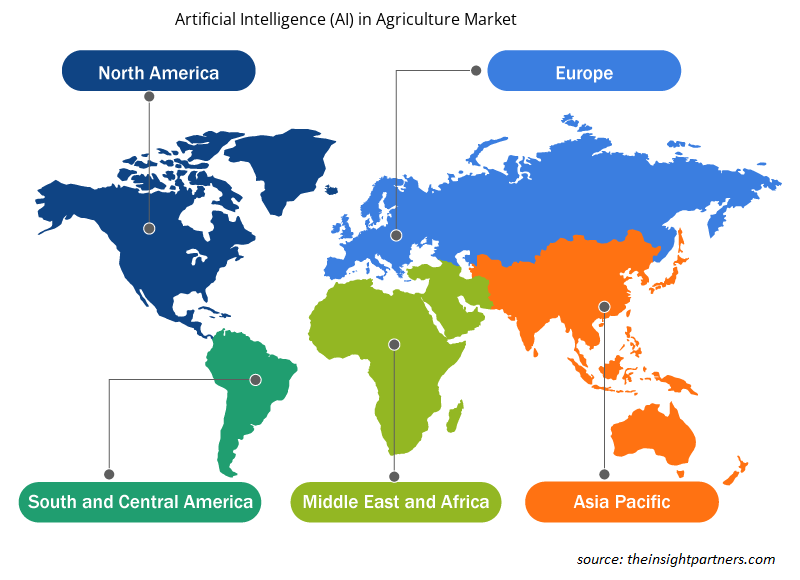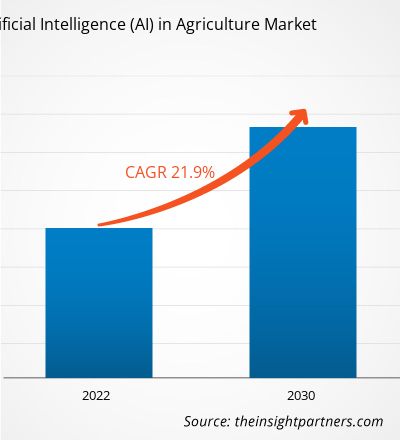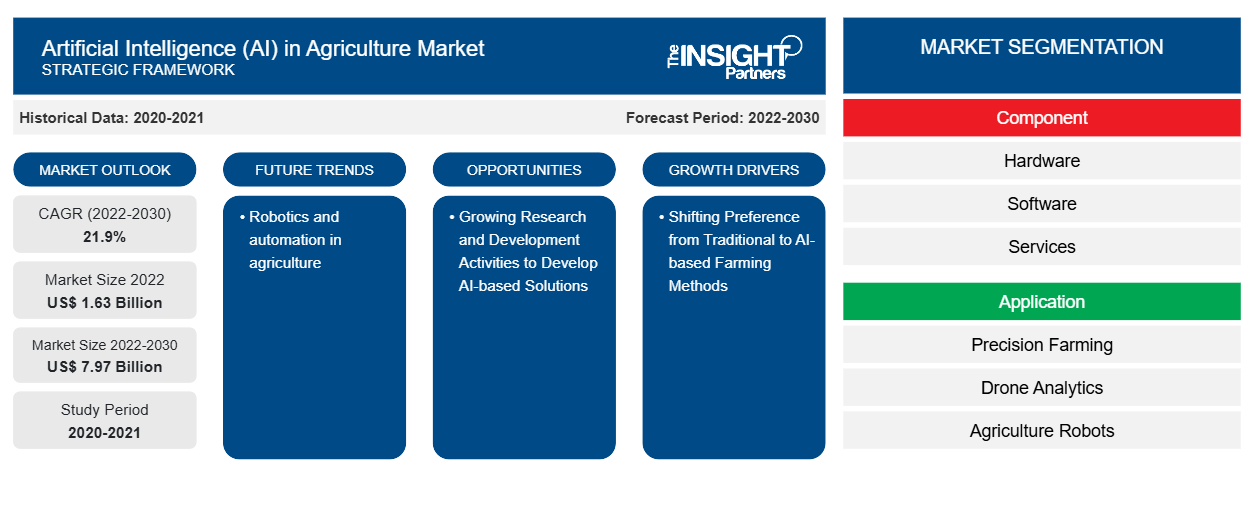농업 분야의 인공지능(AI) 시장 규모는 2022년에 16억 3천만 달러로 평가되었으며, 2030년까지 79억 7천만 달러에 도달할 것으로 예상되며, 2022년부터 2030년까지 21.9%의 CAGR을 기록할 것으로 추산됩니다. 농업 분야의 로봇공학과 자동화는 시장의 주요 트렌드로 남을 가능성이 높습니다.
농업 시장 분석에서의 인공지능(AI)
전통적인 농업 방식에서 AI 기반 농업 방식으로 선호도가 바뀌고, 농업에서 무인 항공기(UAV) 사용이 증가하고, 농업에서 실시간 분석 에 대한 필요성이 증가 하면서 시장이 성장하고 있습니다. AI 솔루션 구현에 대한 정부 지원이 확대되면서 예측 기간 동안 시장이 성장할 것으로 예상됩니다. 게다가 AI 기반 솔루션을 개발하기 위한 연구 개발 활동이 증가하고 스마트 농업이 확대되면서 시장에 수익성 있는 기회가 창출되고 있습니다.
농업 시장 개요의 인공지능(AI)
인공 지능(AI)은 농업 산업에 혁명을 일으키고 있습니다. 예측 분석, 컴퓨터 비전, 머신 러닝, 데이터 분석은 농업이 장애물을 극복하고 잠재력을 최대한 발휘하도록 돕고 있습니다. 농업에서 AI를 사용하면 토양 상태, 기상 패턴, 작물 건강, 과거 데이터를 포함한 다양한 출처에서 데이터를 수집하고 분석할 수 있습니다.
AI 기반 시스템은 농부에게 수확량 증가, 폐기물 감소, 환경 문제 최소화를 위한 귀중한 정보를 제공할 수 있습니다. 농부와 이해 관계자는 데이터 기반 통찰력과 지능적인 의사 결정을 활용하여 생산성을 높이고, 자원 사용을 최적화하고, 농업 문제를 해결할 수 있습니다. 스마트 기계와 로봇 공학은 농업에서 단조로운 작업을 자동화하는 데 사용할 수 있습니다. 이러한 발전은 농장이 인력 부족을 해결하고 전략적 계획 및 관리에 집중하는 데 도움이 됩니다.
귀하의 요구 사항에 맞게 이 보고서를 사용자 정의하세요
이 보고서의 일부 또는 국가 수준 분석, Excel 데이터 팩을 포함하여 모든 보고서에 대한 사용자 정의를 무료로 받을 수 있으며 신생 기업 및 대학을 위한 훌륭한 혜택과 할인 혜택을 이용할 수 있습니다.
-
이 보고서의 주요 시장 동향을 알아보세요.이 무료 샘플에는 시장 동향부터 추정 및 예측까지 다양한 데이터 분석이 포함됩니다.
농업 시장의 인공지능(AI) 동인 및 기회
전통 농업 방식에서 AI 기반 농업 방식으로 선호도 전환
캐나다 전역의 전통적인 감자 재배자들은 작물 수확량에 직접적인 영향을 미치는 농업의 중요한 측면인 영양소 관리에 어려움을 겪었습니다. 토양 처리 및 잎에 먹이를 주는 기존의 방법은 어느 정도 효과적이지만, 특히 감자 성장의 후반 단계에 필요한 영양소의 경우 한계가 있습니다. 따라서 캐나다 전역의 감자 재배자들은 감자 식물의 영양 요구 사항을 예측하기 위해 AI 솔루션을 구축하고 있습니다. 예를 들어, 2023년 11월, 농업 부문에서 획기적인 발전이 이루어지면서 캐나다 감자 재배자들은 실시간으로 작물의 영양 요구 사항을 모니터링하고 예측하기 위해 AI로 전환하고 있습니다. 따라서 캐나다 농부들이 AI를 도입하면서 농업 시장에서 AI의 성장이 촉진됩니다.
AI 기반 솔루션을 개발하기 위한 연구 및 개발 활동 확대
영국은 세계적 수준의 기술과 연구 역량을 자랑하며 AI 기반 솔루션 개발의 글로벌 리더입니다. 게다가 영국 연구자들은 AI를 사용하여 농업과 같은 전통 산업을 혁신하고 있습니다. 2024년 1월 데이터에 따르면, 하퍼 애덤스 대학교의 연구자들은 AI를 사용하여 농업을 더 지속 가능하고 생산적으로 만들려고 노력하고 있습니다.
영국 정부는 또한 농업, 패션, 응급 서비스와 같은 다양한 분야에서 인공지능 프로젝트 개발을 지원하기 위해 3,982만 달러의 자금을 발표했습니다. 소규모 기업의 100개 프로젝트에 대한 타당성 조사에 추가로 538만 달러가 수여되어 다양한 분야에서 생산성을 높이기 위한 혁신적인 AI 아이디어를 육성했습니다. 따라서 이러한 정부 지원은 농업 시장에서 AI의 성장을 촉진할 것으로 예상됩니다.
농업 시장 보고서 세분화 분석의 인공 지능(AI)
농업 시장 분석에서 인공지능(AI) 의 도출에 기여한 핵심 세그먼트는 구성 요소와 응용 프로그램입니다.
- 구성 요소를 기준으로 농업 시장의 인공지능(AI)은 하드웨어, 소프트웨어, 서비스로 나뉩니다. 하드웨어 세그먼트는 2022년에 더 큰 시장 점유율을 차지했습니다.
- 응용 프로그램 측면에서 시장은 정밀 농업, 드론 분석, 농업 로봇, 가축 모니터링 등으로 구분됩니다. 정밀 농업 부문은 2022년에 더 큰 시장 점유율을 차지했습니다.
지역별 농업 시장 점유율 분석의 인공지능(AI)
농업 분야 인공지능(AI) 시장 보고서의 지리적 범위는 주로 북미, 아시아 태평양, 유럽, 중동 및 아프리카, 남미 및 중미의 5개 지역으로 나뉩니다.
아시아 태평양 시장은 기술적으로 진보된 솔루션에 대한 수요가 증가함에 따라 예측 기간 동안 확대될 것으로 예상됩니다. 농업 노동력이 빠르게 고령화되고 있는 호주와 같은 국가에서는 숙련된 노동력에 대한 수요가 그 어느 때보다 큽니다. AI 및 머신 러닝과 같은 최첨단 기술을 통합한 농업은 이러한 격차를 메우고 농업을 현대로 이끄는 열쇠를 쥐고 있습니다. 여러 호주 농부는 이미 AI 구동 시스템의 이점을 목격하고 있습니다. 예를 들어, 2023년 10월, Wamuran의 Sunray Strawberries는 DeepBerry 자동 모니터링 시스템을 구축했습니다. 이 시스템은 시각 및 적외선 이미징을 모두 사용하여 숙성, 멍, 곰팡이, 과일 크기, 모양 및 이물질을 정확하게 감지합니다. 시간당 7,000개 이상의 포넷을 처리할 수 있습니다. 이러한 자동화 시스템을 구현하면 농업 시장에서 AI의 성장이 촉진됩니다.
농업 시장의 인공지능(AI) 지역 통찰력
Insight Partners의 분석가들은 예측 기간 동안 농업 시장에서 인공 지능(AI)에 영향을 미치는 지역적 추세와 요인을 철저히 설명했습니다. 이 섹션에서는 북미, 유럽, 아시아 태평양, 중동 및 아프리카, 남미 및 중미의 농업 시장 세그먼트와 지리에 대해서도 설명합니다.

- 농업 시장에서 인공지능(AI)을 위한 지역별 데이터 얻기
농업 시장 보고서 범위의 인공지능(AI)
| 보고서 속성 | 세부 |
|---|---|
| 2022년 시장 규모 | 16억 3천만 달러 |
| 2030년까지 시장 규모 | 79억 7천만 달러 |
| 글로벌 CAGR (2022-2030) | 21.9% |
| 역사적 데이터 | 2020-2021 |
| 예측 기간 | 2022-2030 |
| 다루는 세그먼트 |
구성 요소별로
|
| 포함된 지역 및 국가 |
북아메리카
|
| 시장 선도 기업 및 주요 회사 프로필 |
|
농업 시장 플레이어 밀도에서의 인공지능(AI): 비즈니스 역학에 미치는 영향 이해
농업 시장 인공지능(AI) 시장은 소비자 선호도의 변화, 기술 발전, 제품의 이점에 대한 인식 증가와 같은 요인으로 인해 최종 사용자 수요가 증가함에 따라 빠르게 성장하고 있습니다. 수요가 증가함에 따라 기업은 제품을 확장하고, 소비자의 요구를 충족하기 위해 혁신하고, 새로운 트렌드를 활용하여 시장 성장을 더욱 촉진하고 있습니다.
시장 참여자 밀도는 특정 시장이나 산업 내에서 운영되는 회사나 기업의 분포를 말합니다. 주어진 시장 공간에 얼마나 많은 경쟁자(시장 참여자)가 존재하는지 그 규모나 총 시장 가치에 비해 나타냅니다.
농업 분야의 인공지능(AI) 시장에서 운영되는 주요 회사는 다음과 같습니다.
- 툴 테크놀로지 주식회사
- 프리시전호크 주식회사
- 이지투시 애그텍 SL
- 디어앤코
- 기후 유한회사
- 가마야 SA
면책 조항 : 위에 나열된 회사는 어떤 특별한 순서에 따라 순위가 매겨지지 않았습니다.

- 농업 시장의 인공 지능(AI)에 대한 주요 주요 업체 개요를 알아보세요
농업 시장의 인공지능(AI) 뉴스 및 최근 동향
농업 시장에서의 인공지능(AI)은 1차 및 2차 연구 이후의 질적, 양적 데이터를 수집하여 평가되며, 여기에는 중요한 기업 간행물, 협회 데이터 및 데이터베이스가 포함됩니다. 농업 시장에서의 인공지능(AI)의 몇 가지 개발 사항은 다음과 같습니다.
- Chipotle Mexican Grill은 Greenfield Robotics와 Nitricity에 대한 소수 지분 투자를 발표했습니다. Chipotle의 투자는 Greenfield Robotics가 자사 차량을 확장하고 마이크로 분무, 피복 작물 심기, 토양 테스트와 같은 로봇에 대한 추가 기능을 개발하는 데 도움이 될 것입니다. (출처: Chipotle Mexican Grill, 회사 웹사이트, 2023년 12월).
농업 시장 보고서의 인공지능(AI) 범위 및 제공물
"농업 분야의 인공지능(AI) 시장 규모 및 예측(2020-2030)" 보고서는 아래 영역을 포괄하는 시장에 대한 자세한 분석을 제공합니다.
- 범위에 포함된 모든 주요 시장 세그먼트에 대한 글로벌, 지역 및 국가 수준의 농업 시장 규모 및 예측
- 농업 시장 동향의 인공지능(AI)과 동인, 제약, 주요 기회와 같은 시장 역학
- 자세한 PEST/포터의 5가지 힘과 SWOT 분석
- 주요 시장 동향, 글로벌 및 지역 프레임워크, 주요 참여자, 규정 및 최근 시장 개발 사항을 포괄하는 농업 분야의 인공 지능(AI) 시장 분석
- 시장 집중도, 히트맵 분석, 유명 기업, 농업 시장에서의 인공지능(AI)에 대한 최근 개발 사항을 포함하는 산업 환경 및 경쟁 분석
- 자세한 회사 프로필
- 과거 분석(2년), 기준 연도, CAGR을 포함한 예측(7년)
- PEST 및 SWOT 분석
- 시장 규모 가치/거래량 - 글로벌, 지역, 국가
- 산업 및 경쟁 환경
- Excel 데이터세트
최근 보고서
사용 후기
구매 이유
- 정보에 기반한 의사 결정
- 시장 역학 이해
- 경쟁 분석
- 고객 인사이트
- 시장 예측
- 위험 완화
- 전략 기획
- 투자 타당성 분석
- 신흥 시장 파악
- 마케팅 전략 강화
- 운영 효율성 향상
- 규제 동향에 발맞춰 대응























 무료 샘플 받기 - 농업 시장의 인공지능(AI)
무료 샘플 받기 - 농업 시장의 인공지능(AI)